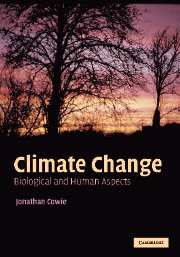Book contents
- Frontmatter
- Contents
- Introduction
- Acknowledgements
- 1 An introduction to climate change
- 2 Principal indicators of past climates
- 3 Past climate change
- 4 The Oligocene to the Quaternary: climate and biology
- 5 Present climate and biological change
- 6 Current warming and likely future impacts
- 7 The human ecology of climate change
- 8 Sustainability and policy
- Appendix 1 Glossary and abbreviations
- Appendix 2 Bio-geological chronology
- Appendix 3 Calculations of energy demand/supply and orders of magnitude
- Appendix 4 The IPCC 2007 report
- Index
- References
7 - The human ecology of climate change
Published online by Cambridge University Press: 17 December 2010
- Frontmatter
- Contents
- Introduction
- Acknowledgements
- 1 An introduction to climate change
- 2 Principal indicators of past climates
- 3 Past climate change
- 4 The Oligocene to the Quaternary: climate and biology
- 5 Present climate and biological change
- 6 Current warming and likely future impacts
- 7 The human ecology of climate change
- 8 Sustainability and policy
- Appendix 1 Glossary and abbreviations
- Appendix 2 Bio-geological chronology
- Appendix 3 Calculations of energy demand/supply and orders of magnitude
- Appendix 4 The IPCC 2007 report
- Index
- References
Summary
Given that climate change has been part of, and has helped shape, the biosphere's development, it should not have been surprising that climate change affected human evolution and humanity's historical affairs (see Chapter 5), or that it will do so in the future. That humanity itself has affected the climate – modern technological civilisation significantly so – all the more demonstrates the interconnections between climate and our species. If we are to begin to assess this relationship's future it is necessary to understand the relevant fundamentals of human ecology (the way our species as a population develops and its relations with other species). This includes population demographics (broadly our numbers reflect the amount of biomass of, and hence impact on, the species to which we relate), energy supply (which relates to carbon-cycle short-circuiting), health (mainly with regard to those species that prey on us) and food supply (those species which we harvest). Finally, given all of this, what are the prospects for limiting, or ameliorating, our short-circuiting of the biosphere's carbon cycle?
Population (past, present and future) and its environmental impact
Population and environmental impact
Generally, if one person has an environmental impact of some arbitrary quantification, x, then it is not unreasonable to suppose that two people will have an impact of 2x, three people an impact of 3x, etc; in other words, that environmental impact is proportional to population and so may be represented in equation form.
- Type
- Chapter
- Information
- Climate ChangeBiological and Human Aspects, pp. 310 - 391Publisher: Cambridge University PressPrint publication year: 2007

